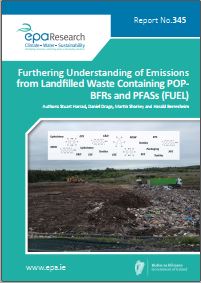Research 345: Furthering Understanding of Emissions from Landfilled Waste Containing POPBFRs and PFASs (FUEL)
Authors: Stuart Harrad, Daniel Drage, Martin Sharkey and Harald Berresheim
Summary: Brominated flame retardants (BFRs) and perfluoroalkyl substances (PFASs) have been used extensively in applications such as electrical goods, soft furnishings and building insulation foam. The FUEL project measured these chemicals in leachate from landfills, and collected air, soil and groundwater samples traceable to these landfills to further investigate.

Project Highlights
Watch the FUEL project highlights
Identifying Pressures
Brominated flame retardants (BFRs) and perfluoroalkyl substances (PFASs) have found extensive use in applications such as electrical goods, soft furnishings and building insulation foam. Given their environmental persistence, ability to bioaccumulate and adverse health effects, some BFRs and PFASs are listed under the Stockholm Convention on Persistent Organic Pollutants (POPs), an international treaty designed to eliminate POPs and to which Ireland is a Party. Although the manufacture and use of such substances has been severely restricted, there remains a substantial mass of materials that has entered the waste stream and will continue to do so for some years. Moreover, despite national and European Union policies limiting landfill use, many waste materials containing BFRs and PFASs are likely to be present in Irish landfills. This is concerning, as reports from other countries show that landfill leachate contains such substances. The FUEL study measured PFASs, polybrominated diphenyl ethers (PBDEs) and hexabromocyclododecane (HBCDD) in leachate from 40 landfills within Ireland. In a second phase of the study, air and soil samples were collected from locations downwind and upwind of 10 Irish landfills. Groundwater was also collected from locations traceable to these landfills.
Informing Policy
Concentrations of BFRs and PFASs in leachate from Irish landfills were within the range reported elsewhere. Average concentrations of PFASs exceeded those of PBDEs and HBCDD. Concentrations of some PBDEs and PFASs were significantly higher in leachate from newer, lined landfills than in samples from unlined landfills, implying that lined landfills are less likely to release leachate to the environment. Consistent with this, the average concentration of perfluorooctanoic acid (PFOA) in groundwater from landfills that were not fully lined (n = 4; 69 ng/L) exceeded that in groundwater sourced from lined landfills (n = 6; 4.1 ng/L). Concentrations of PFASs and BFRs in air and soil samples were not significantly different between downwind and upwind locations, suggesting that the landfills studied are not a significant source of these substances in the surrounding air and soil. The BFR decabromodiphenyl ethane (DBDPE) was detected in groundwater for the first time anywhere, in all samples at concentrations (median = 9.4 ng/L) that exceeded those of any of the other BFRs or PFASs measured. This probably reflects the use of DBDPE as a replacement for the recently restricted BFR POP, decabromodiphenyl ether.
Developing Solutions
The findings of the FUEL study suggest that concentrations of PFASs in groundwater potentially impacted by unlined or partially lined landfills should be monitored closely. Moreover, as concentrations in leachate of many BFRs and PFASs correlated significantly with those of chemical oxygen demand – an indicator of organic matter content – leaching of BFRs and PFASs may be minimised by reducing the organic matter content of leachate. Further monitoring in landfill leachate and groundwater of concentrations of DBDPE and other chemicals designed as replacements for restricted BFRs and PFASs is recommended. Given the widespread application of BFRs and PFASs to textiles, restrictions on the landfilling of such material would reduce the quantity of such substances in waste materials entering landfill. Moreover, as leachate from modern landfills is collected and subjected to treatment, further research should be conducted into methods for removing PFASs from landfill leachate.
https://www.epa.ie/media/epa-2020/monitoring-amp-assessment/waste/Thumbnail_345.jpg